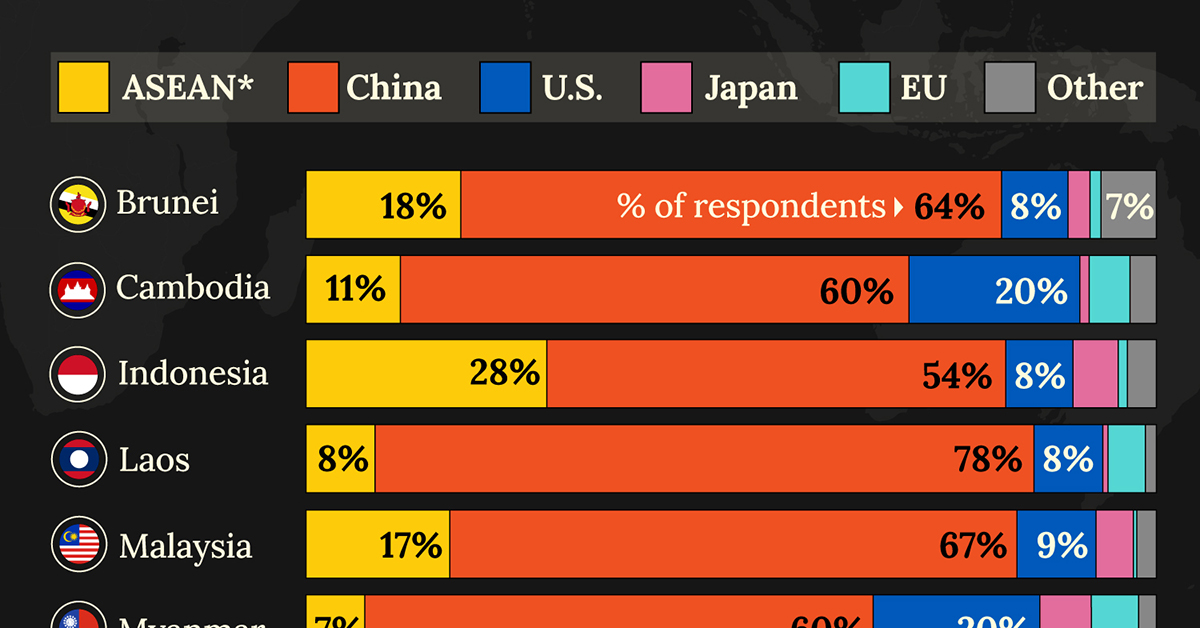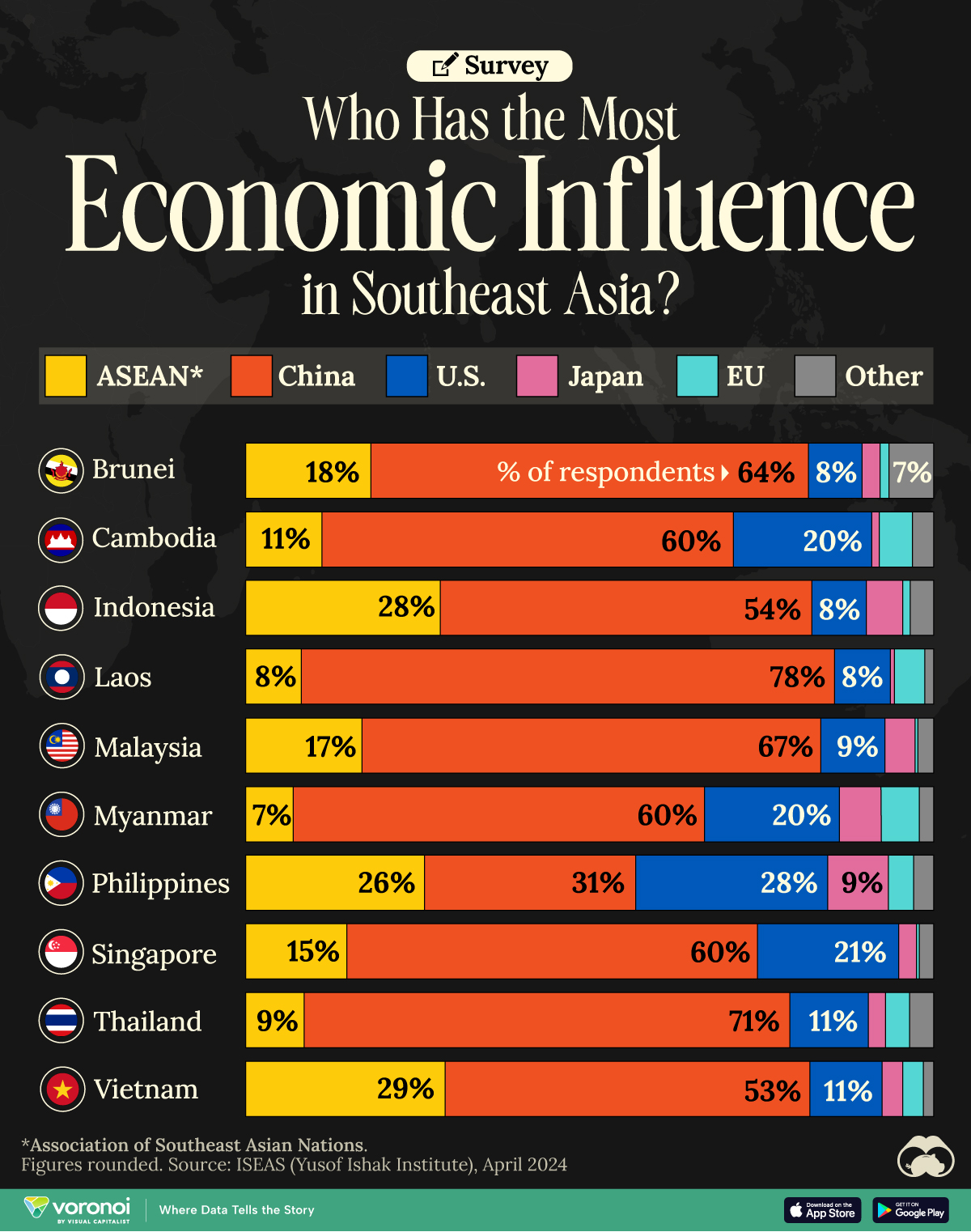Politics
Charted: Trust in Government Institutions by G7 Countries
![]() See this visualization first on the Voronoi app.
See this visualization first on the Voronoi app.
Trust in Government Institutions by G7 Countries
This was originally posted on our Voronoi app. Download the app for free on iOS or Android and discover incredible data-driven charts from a variety of trusted sources.
How much do you trust the government, and its various institutions?
It’s likely that your level of confidence probably depends on a wide range of factors, such as perceived competency, historical context, economic performance, accountability, social cohesion, and transparency.
And for these same reasons, trust levels in government institutions also change all the time, even in the world’s most developed countries: the G7.
Confidence in Government by G7 Countries (2006-2023)
This chart looks at the changes in trust in government institutions between the years 2006 and 2023, based on data from a multi-country Gallup poll.
Specifically, this dataset aggregates confidence in multiple national institutions, including the military, the judicial system, the national government, and the integrity of the electoral system.
| Country | Confidence (2006) | Confidence (2023) | Change (p.p.) |
|---|---|---|---|
| Canada | 57% | 64% | +7 |
| Britain | 63% | 63% | +0 |
| Germany | 55% | 61% | +6 |
| France | 54% | 60% | +6 |
| Japan | 48% | 59% | +11 |
| Italy | 41% | 54% | +13 |
| United States | 63% | 50% | -13 |
What’s interesting here is that in the G7, a group of the world’s most developed economies, there is only one country bucking the general trend: the United States.
Across most G7 countries, confidence in institutions has either improved or stayed the same between 2006 and 2023. The largest percentage point (p.p.) increases occur in Italy and Japan, which saw +13 p.p. and +11 p.p. increases in trust over the time period.
In the U.S., however, confidence in government institutions has fallen by 13 p.p. over the years. What happened?
Key Figures on U.S. Trust in Institutions
In 2006, the U.S. was tied with the UK as having the highest confidence in government institutions, at 63%.
But here’s where the scores stand in 2023, across various institutions:
| 🇺🇸 Institutions | Confidence (2023) |
|---|---|
| Military | 81% |
| Judiciary | 42% |
| National Government | 30% |
| Elections | 44% |
| Overall | 49% |
Based on this data, it’s clear that the U.S. lags behind in three key indicators: confidence in the national government, confidence in the justice system, and confidence in fair elections. It ranked in last place for each indicator in the G7.
One other data point that stands out: despite leading the world in military spending, the U.S. is only the third most confident in its military in the G7. It lags behind France (86%) and the United Kingdom (83%).
China
Which Countries Have the Most Economic Influence in Southeast Asia?
One country dominates this survey of who has the most economic influence in the region.

Countries With the Most Economic Influence in Southeast Asia
This was originally posted on our Voronoi app. Download the app for free on iOS or Android and discover incredible data-driven charts from a variety of trusted sources.
This chart visualizes the results of a 2024 survey conducted by the ASEAN Studies Centre at the ISEAS-Yusof Ishak Institute.
Nearly 2,000 respondents from 10 countries were asked to select which country/region they believe has the most influential economic power in Southeast Asia.
The countries surveyed are all member states of the Association of Southeast Asian Nations (ASEAN), a political and economic union of 10 countries in Southeast Asia.
Southeast Asia Perceptions: Who’s Got Economic Influence?
Across all ASEAN nations, China is regarded as the region’s most influential economic power.
Laos and Thailand had the highest share of respondents picking China, at 78% and 71% respectively. As the report points out, China is Laos’ largest foreign investor as well as its top export market.
| Country | 🇨🇳 China | 🌏 ASEAN | 🇺🇸 U.S. |
|---|---|---|---|
| 🇧🇳 Brunei | 64% | 18% | 8% |
| 🇰🇭 Cambodia | 60% | 11% | 20% |
| 🇮🇩 Indonesia | 54% | 28% | 8% |
| 🇱🇦 Laos | 78% | 8% | 8% |
| 🇲🇾 Malaysia | 67% | 17% | 9% |
| 🇲🇲 Myanmar | 60% | 7% | 20% |
| 🇵🇭 Philippines | 31% | 26% | 28% |
| 🇸🇬 Singapore | 60% | 15% | 21% |
| 🇹🇭 Thailand | 71% | 9% | 11% |
| 🇻🇳 Vietnam | 53% | 29% | 11% |
Note: Percentages are rounded.
Other ASEAN countries usually score highly as well, along with the United States.
It’s only in the Philippines, where China (31%), the U.S. (28%) and ASEAN (26%) were perceived as having a similar amount of influence.
ASEAN, Japan, and the EU
Filipinos also rated Japan’s economic influence the highest (9%) compared to those surveyed in other ASEAN countries. In 2023, the Southeast Asian bloc celebrated 50 years of friendship with Japan, marking it as one of their most important “dialogue partners.”
| Country | 🇯🇵 Japan | 🇪🇺 EU | 🌐 Other |
|---|---|---|---|
| 🇧🇳 Brunei | 3% | 1% | 7% |
| 🇰🇭 Cambodia | 1% | 5% | 3% |
| 🇮🇩 Indonesia | 5% | 1% | 3% |
| 🇱🇦 Laos | 1% | 4% | 1% |
| 🇲🇾 Malaysia | 4% | 0% | 2% |
| 🇲🇲 Myanmar | 6% | 6% | 2% |
| 🇵🇭 Philippines | 9% | 4% | 3% |
| 🇸🇬 Singapore | 3% | 0% | 2% |
| 🇹🇭 Thailand | 3% | 4% | 4% |
| 🇻🇳 Vietnam | 3% | 3% | 2% |
Note: Percentages are rounded. Other countries include: Australia, South Korea, India, and the UK.
The EU also received single-percentage responses, its highest share coming from Myanmar (6%), Cambodia (5%), and Laos (4%).
Finally, the report contrasted China’s robust economic influence with concerns about its growing impact in the region. Respondents from Vietnam (88%), Myanmar (88%), and Thailand (80%) had the highest levels of concern, despite their countries’ strong trade ties with China.
-

 Culture5 days ago
Culture5 days agoHow Popular Snack Brand Logos Have Changed
-

 Markets2 weeks ago
Markets2 weeks agoMapped: The Most Valuable Company in Each Southeast Asian Country
-

 Technology1 week ago
Technology1 week agoMapped: The Number of AI Startups By Country
-

 Healthcare1 week ago
Healthcare1 week agoLife Expectancy by Region (1950-2050F)
-

 Markets1 week ago
Markets1 week agoThe Growth of a $1,000 Equity Investment, by Stock Market
-

 Markets1 week ago
Markets1 week agoMapped: Europe’s GDP Per Capita, by Country
-

 Money1 week ago
Money1 week agoCharted: What Frustrates Americans About the Tax System
-

 Technology1 week ago
Technology1 week agoCountries With the Highest Rates of Crypto Ownership















